Téléchargements
Exécutable de l'éditeur de niveaux (Windows 32bits)
Exécutable du jeu (Windows 32bits)
Avant d'essayer de compiler le code, allez dans l'onglet "Projets" dans le menu de gauche, séléctionnez l'onglet "Run" pour votre kit,
et mettez dans "Working directory" le chemin de "editor\data" pour l'éditeur ou "game\data" pour le jeu.
Réparer les portes
Certains n'avaient pas la même couleur que la porte, et des parties des décors transparents étaient manquantes à
cause du redimensionnement.
Pour réparer ça, on va dessiner les portes d'une nouvelle façon.
D'abord, on ne va pas utiliser toutes les images des portes, seulement la plus proche.
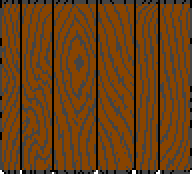
Ensuite, on va dessiner le décor dessus, en rendant éventuellement les pixels transparents si nécessaire.
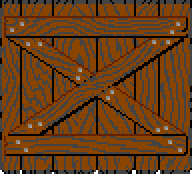

Finalement, on va assombrir et redimensionner l'image complète.

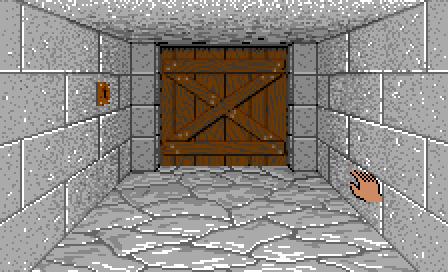
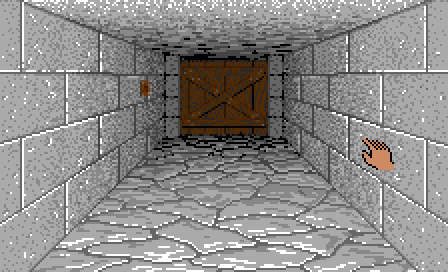
C'est ce que l'on fait dans la fonction drawDoor().
void CDoors::drawDoor(QImage* image, CVec2 tablePos, CTile* tile)
{
SDoorElem& cell = tabDoor[tablePos.y][tablePos.x];
int doorNum = cell.file[0] - '0';
if (doorNum >= 0)
{
//----------------------------------------------------------------------------
// récupère l'image de la porte
int doorType = tile->getDoorParam("Type");
std::string fileName = std::string("gfx/3DView/doors/") + doorsDatas[doorType].files[2].toUtf8().constData();
QImage doorImage = fileCache.getImage(fileName);
//----------------------------------------------------------------------------
// récupère l'image du décor
int ornateType = tile->getDoorOrnateParam("Decor");
std::string ornateName = doorOrnatesDatas[ornateType].file.toUtf8().constData();
QImage ornateImage;
CVec2 ornatePos;
if (ornateName.empty() == false)
{
ornateImage = fileCache.getImage(std::string("gfx/3DView/door_ornates/") + ornateName);
ornatePos = doorOrnatesDatas[ornateType].pos;
graph2D.drawImage(&doorImage, ornatePos, ornateImage);
// décors avec transparence
if (ornateType == DOOR_ORNATE_ARCHED || ornateType == DOOR_ORNATE_ARCHED + 1)
{
QSize qSize = ornateImage.size();
for (int y = 0; y < qSize.height(); ++y)
for (int x = 0; x < qSize.width(); ++x)
{
QRgb pixel = ornateImage.pixel(x, y);
if (qRed(pixel) == 204 &&
qGreen(pixel) == 136 &&
qBlue(pixel) == 102)
{
CVec2 destPos = ornatePos + CVec2(x, y);
doorImage.setPixel(destPos.x, destPos.y, 0);
}
}
}
}
//----------------------------------------------------------------------------
// assombrit
static const float shadowLevels[] = {0.0f, 0.2f, 0.4f};
float shadow = shadowLevels[WALL_TABLE_HEIGHT - 2 - tablePos.y];
graph2D.darken(&doorImage, shadow);
//----------------------------------------------------------------------------
// dessin
static const int doorScalesX[] = {96, 64, 44};
static const int doorScalesY[] = {88, 61, 38};
float scaleX = (float)doorScalesX[WALL_TABLE_HEIGHT - 2 - tablePos.y] / 96.0;
float scaleY = (float)doorScalesY[WALL_TABLE_HEIGHT - 2 - tablePos.y] / 88.0;
bool isHorizontal = tile->getBoolParam("estHorizontale");
int doorPos = tile->getIntParam("pos") / DOOR_POS_FACTOR;
if (isHorizontal == false)
{
//----------------------------------------------------------------------------
// porte verticale
doorPos *= scaleY;
CVec2 pos(cell.x, cell.y + doorPos);
QRect clip(cell.cx1, cell.cy1,
cell.cx2 - cell.cx1 + 1, cell.cy2 - cell.cy1 + 1);
clipToMainView(&clip);
if (clip.width() > 0 && clip.height() > 0)
graph2D.drawImageScaled(image, pos, doorImage, scaleX, false, scaleY, clip);
}
else
{
//----------------------------------------------------------------------------
// porte horizontale
doorPos *= scaleX;
CVec2 pos(cell.x + doorPos, cell.y);
int halfwidth = (cell.cx2 - cell.cx1 + 1) / 2;
QRect clip1(cell.cx1, cell.cy1,
halfwidth + doorPos, cell.cy2 - cell.cy1 + 1);
clipToMainView(&clip1);
if (clip1.width() > 0 && clip1.height() > 0)
graph2D.drawImageScaled(image, pos, doorImage, scaleX, false, scaleY, clip1);
pos.x = cell.x - doorPos;
QRect clip2(cell.cx1 + halfwidth - doorPos, cell.cy1,
halfwidth + doorPos, cell.cy2 - cell.cy1 + 1);
clipToMainView(&clip2);
if (clip2.width() > 0 && clip2.height() > 0)
graph2D.drawImageScaled(image, pos, doorImage, scaleX, false, scaleY, clip2);
}
}
}
L'ombre des objets
Comme dans le jeu d'origine, j'ai simplement dessiné une copie noire de l'objet 2 pixels à droite et en bas du
curseur.
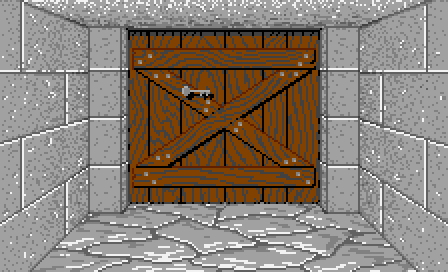
Les boutons
<ornate name="Levier Off">
<image_front>Lever_Off_front.png</image_front>
<image_side>Lever_Off_side.png</image_side>
<pos_front x="105" y="69"/>
<pos_side x="47" y="72"/>
</ornate>
<ornate name="Levier On">
<image_front>Lever_On_front.png</image_front>
<image_side>Lever_On_side.png</image_side>
<pos_front x="105" y="69"/>
<pos_side x="47" y="72"/>
</ornate>
<wall name="Bouton">
<image>Switch.png</image>
<param type="enum" values="Levier;Bouton vert;Bouton blau;Gros bouton">Type</param>
<param type="script">siOn</param>
<param type="script">siOff</param>
<param type="bool">estOn</param>
</wall>
Vous verrez qu'on n'aura pas seulement à ouvrir des portes comme dans la dernière partie.
Il va y avoir pas mal de nouvelles commandes dans les scripts.
L'alcôve cachée
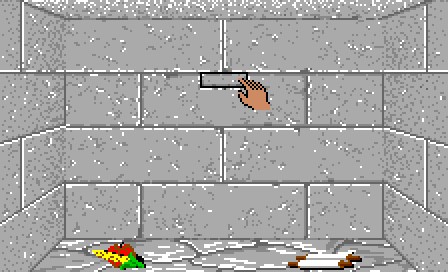
Une fois que vous le pressez, il disparait et il est remplacé par une alcôve avec un cimeterre à l'intérieur.
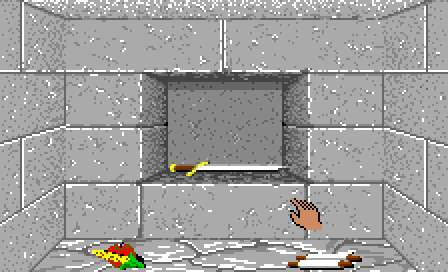
Alors il nous faut 3 commandes pour ce script:
Target Wall 6 3 down
SetType 5
SetEnum Type 1
AddObject 10
SetEnum change le type de cette alcôve en une alcôve carrée.
Et AddObject ajoute le cimeterre au tas de la target courante (c'est-à-dire le tas associé à l'alcôve).
Leurs codes sont assez simples. Au passage, j'ai du changer la fonction executeTarget() pour garder la trace de la
position et du coté de la target, et pas seulement un pointeur dessus.
//--------------------------------------------------------------------------
void CScripts::executeSetType(std::vector<std::string>& words)
{
int type = stoi(words[1]);
if (mTargetType == eTargetType_Tile)
{
}
else
{
CWall* target = (CWall*)mTarget;
target->setType(type);
}
}
//--------------------------------------------------------------------------
void CScripts::executeSetEnum(std::vector<std::string>& words)
{
QString param = QString::fromStdString(words[1]);
int type = stoi(words[2]);
if (mTargetType == eTargetType_Tile)
{
}
else
{
CWall* target = (CWall*)mTarget;
target->setEnumParam(param, type);
}
}
//--------------------------------------------------------------------------
void CScripts::executeAddObject(std::vector<std::string>& words)
{
int type = stoi(words[1]);
CObjectStack* stack = map.addObjectsStack(mTargetPos, mTargetSide);
CObject newObj;
newObj.setType(type);
stack->addObject(newObj);
}
Les 2 boutons suivants
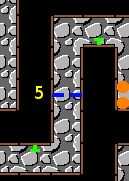
Le 2ième bouton qu'on rencontre ouvre seulement la porte 5. Alors il sera associé à 2 scripts: "L02_OpenDoor05.txt"
Target Tile 5 9
SetBool estOuverte true
Target Tile 5 9
SetBool estOuverte false
Le puzzle de la porte 19

Le bouton suivant apparaît à coté de la porte 19, et il l'ouvre.
Mais il fait partie d'un petit puzzle car la plaque de pression à coté de lui referme la porte.
Il n'y a rien de spécial ici. Le bouton est associé à un script "L02_OpenDoor19.txt", et la plaque est associée
à un "L02_CloseDoor19.txt".
Remarquez que le script du bouton est appelé quand il est mis sur "on" ou sur "off".
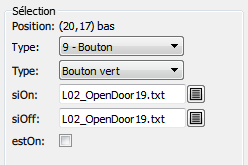
Le puzzle de la porte 20
2 couloirs ici.

L'astuce est que ces leviers doivent tous les 2 être sur "on" pour ouvrir la porte.
Alors dans chaque script de ces boutons, j'ai ajouté une commande "If" pour tester l'état de l'autre bouton.
Target Tile 18 20
If Wall 22 19 right isOn
SetBool estOuverte true
Pour effectuer ça, j'ai seulement du ajouter le test d'un booléen dans executeLine():
void CScripts::executeLine(std::vector<std::string>& words)
{
if (lastIf == true)
{
if (words[0] == "Target")
executeTarget(words);
else if (words[0] == "SetBool")
executeSetBool(words);
else if (words[0] == "SwitchBool")
executeSwitchBool(words);
else if (words[0] == "SetType")
executeSetType(words);
else if (words[0] == "SetEnum")
executeSetEnum(words);
else if (words[0] == "AddObject")
executeAddObject(words);
else if (words[0] == "If")
executeIf(words);
else if (words[0] == "SetString")
executeSetString(words);
}
else
{
lastIf = true;
}
}
La porte 24 et la pièce cachée

La porte 24 est ouverte par un levier dans la petite pièce à gauche.
Derrière cette porte, il y a un autre levier qui fait disparaître certains murs de la pièce à cote.
Pour réaliser ça il faut juste qu'on change le type de ces murs.
Target Wall 14 28 down
SetType 0
Target Wall 13 29 right
SetType 0
Le texte que disparait

Après être passé par la porte 16, vous rencontrez une plaque de pression et vous voyez un texte sur un mur plus
loin.
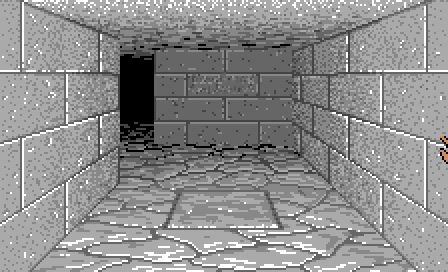
Le truc, c'est que si cous marchez sur la plaque, dès que vous la quittez, le texte disparait.
Vous devez laisser un objet sur la plaque pour être capable de lire ce texte.
Pour cacher le texte, on a seulement à changer le type du mur.
Target Wall 22 8 left
SetType 1
paramètre "Texte".
Target Wall 22 8 left
SetType 6
SetString Texte WALL_TEXT03
void CScripts::executeSetString(std::vector<std::string>& words)
{
QString param = QString::fromStdString(words[1]);
if (mTargetType == eTargetType_Tile)
{
}
else
{
((CWall*)mTarget)->setStringParam(param, words[2]);
}
}